HINDU WEDDINGS
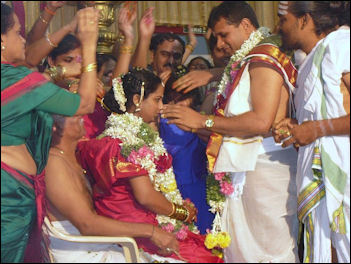
Hindu marriage blessingWeddings in India are often highly complex, and involve huge expenditures and the feeding of a lot of people. A typical wedding, and all that goes with it, lasts for three to seven days, with a 100 or more people, mostly relatives, attending. Customs vary according to region, caste, ethnic group, religion and income levels of the families involved.
Marriage has traditionally been viewed as an initiation with betrothal, virginity, acceptance and the seven steps being the essential elements of a wedding. During the wedding the couple spends much of its time seated inside a small pavilion . The bride's father formally give the bride to the groom. To signify they are married some women wear a ring on the toe next to their big toe.
Marriage ceremonies generally include the donning of a nose ring by the bride, or in South India a wedding necklace, and the procession of the bridegroom. In a traditional wedding, males and females attend ceremonies in different rooms, in keeping with the segregation of sexes in most social settings. Weddings have traditionally taken place at a home or in a tent filled with decorations and flowers. If the bride’s family is wealthy it might be held in a courtyard of the bride’s house. If the family doesn’t have so much money it be held in a blocked off street or square. The groom and his relatives and friends traditionally traveled to the bride's house, neighborhood of village for the wedding.
The winter is traditionally the wedding season. February is the main month for weddings in New Delhi. March is the favored month in other places. The dates are usually chosen by astrologers, who pour over elaborate birth charts of the bride and groom to chose the most auspicious days and times. Some weeding take lace in pre-dawn ceremonies.
The cost of a wedding and a dowry can be a great expense for a family, It is not unusual for poor man to take ten years or more to pay off the debts incurred from one marriage. Wedding gifts of cash often go the family hosting the wedding to help defer some f the wedding costs.
Websites and Resources on Hinduism: heart of Hinduism hinduism.iskcon.com/index ; India Divine indiadivine.org ; Hinduism Today hinduismtoday.com ; ; Religious Tolerance Hindu Page religioustolerance.org/hinduism ; Hinduism Index uni-giessen.de/~gk1415/hinduism ; Hindu Universe hindunet.org ; Wikipedia article Wikipedia ; Oxford center of Hindu Studies ochs.org.uk ; Hinduism Home Page uwacadweb.uwyo.edu/religionet/er/hinduism ; Hindu Website hinduwebsite.com/hinduindex ; Hindu Gallery hindugallery.com ; Hindusim Today Image Gallery himalayanacademy.com/resources/books/wih/image-library ; India Divine Pictures of Hinduism indiadivine.org/pictures
Hindu Wedding Clothes

Hindu bride at a wedding in Ahmedabad
Hindu, Muslim and Sikh brides have traditionally worn a sari, salwar kurta (suit), choli (blouse) and/ or lahenga (skirt) along with a variety of jewelry on their wedding day. The costume is often embroidered with gold and features adornments that have symbolic value. Over their head they wear a long piece of bright red, yellow, green or magenta material called a chuni. In some places the bride covers her entire head with a pallav, that is intend to protect the most beautiful part of the body, the head, from the evil eye. In other places a ghungat that covers the bride’s head and face can only be removed by the bridegroom. Varanasi is famous for producing bridal brocades embedded with semi-precious stones and embroidered with gold threads.
In northern India. Hindu and Muslim brides have traditionally worn an elaborate red sari with a green choli. The chuni is usually red. Red is regarded as the luckiest color for Indian brides. In some places yellow saris are favored. In northeastern India, brides wear a white sari with a red border. In southern India they wear a yellow, green or white sari made of Kanjeevaram silk. In the western states of Rajasthan an Gujarat the bride wears aan embroidered skirt decorated with small pieces of mirrored glasses and glass and a waist-length blouse.
The bride often wears a decorative scarf and dress along with a tikka (a jewel worn dangling over the forehead) as well as necklaces, bangles, large earnings and a nose ring. In most places the bride wears silver anklets called payalas that make a tinkling sound when the bride walks and mangalsutra, gold chains with black beads and yellow string necklace with a jewel that symbolized a positive future. Jewels and gold are commonly given as dowry presents from the mother to daughter.
Different designs are associated with different regions, castes and ethnic groups. In northern India, the bride often has a gold chain dangling between the nose In the south diamond staids places on both sides of the nose symbolize the loss virginity.
Grooms in northern India wear a chruidar kameez, a silk robe worn with tight leggings on their wedding day. Some Hindu men wear a traditional long white silk jacket with an erect collar, white pants and an elaborately jeweled turban. At fancy weddings the groom wears sarpech, a diamond-studded feathered ornament owned for generations by his family. Some wear Western suits. Often the bride and groom have flowers in their hair and wear garlands places around their necks by family members.
Preparations for a Hindu Wedding

Aarathi There is a great deal of preparation and ritual before a Hindu wedding. Relatives and friends of the groom are expected to travel to the village or town of the bride. After they arrive a welcoming ceremony is held for them. Often colored lights are strung up, and a band is hired to play and several hundred people feast on something like lentil stew and tamarind chutney while Bollywood tunes blast from loudspeakers.
Several days before the wedding women gather for a party in which the bride’s hands and feet are decorated with mehendi (henna) paste. In northern India, elaborate mehendi designs are painted on the palms of the feet and hands by a mehindiwalli while female friends sing traditional songs. Both Hindu and Muslim women have their hands painted with henna for good luck before a wedding. If the color remains it means that the husbands love will remain strong. In central India the grooms hands are decorated with henna-leaf paste that when washed away leaves behind bright orange designs. Henna Tattoos, see Beauty
Before the wedding ceremony a great deal of time is spent applying the bride’s make up and making sure where jewelry is just so. In preparation for the marriage of a Brahmin bride she is anointed with purifying turmeric paste and serenaded with wedding songs for several days.
Sometimes the groom is not allowed to see bride until the ceremony. Other times he dines at the bride’s house before the ceremony, and stands on a wooden platform with the bride with a Brahmin holding a curtain between them. While a maternal uncle and female relatives surround the bride, the priest chants marriage songs and guest throw rice and other grains on the couple.
Hindu Wedding Procession
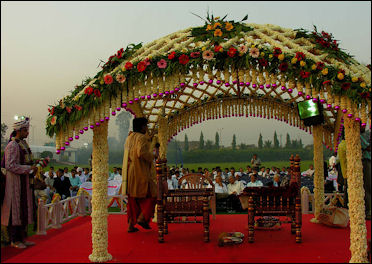
wedding tent A traditional Hindu ceremony is often held at night, typically around 11:00pm. The time is often selected by an astrologer based on the couple’s horoscope and the positions of the stars and planets. Sometimes the groom will make a dramatically entrance on horseback with a sword. In Varanasi and Rajasthan and other places, the bride and groom are often carried to their wedding on elephants or horses or a fancy car draped in tinsel and brocade.
The barat, or wedding procession, is a fixture of Indian weddings. It is usually led by a groom on a white horse and is accompanied by a brass band with a dozen or so musicians, often including tuba players and drummers in Western band uniforms, and boys carrying candelabras connected to generators. The musicians are often migrant bandwallahs who travel the country during the wedding season. Typically half their repertoire is made up of popular Bollywood songs at the time of the wedding. By one estimate between 500,000 and 1 million people make a living playing brass band music at weddings in India.
Hindu Wedding Ceremony
A traditional Hindu wedding and ceremony is presided over by a Brahmin priest. The bride is shaded by a tent-like saffron canopy decorated with flowers and surrounded by wedding guests. The formal ceremony often begins with the couple standing on a platform and the curtain between them is removed and sandalwood chips are placed around their necks.
The ceremony is held before a sacred fire lit inside a metal vessel. The sacred fire is a symbol of purification and a representation of Agni, the fire god. It burns underneath the saffron canopy and is made with specific kinds of wood, often mango wood, and is kindled by rubbing sticks together in a proscribed fashion. Before the fire the priest recites sacred Sanskrit texts to drive off darkness while the couple throws offerings of puffed rice and clarified butter. In Aryan times the fire was never allowed to go out and into it daily offering were made to the gods.
Seven Steps Around the Sacred Fire
The central ritual of a Hindu wedding is the sapta-pad, the seven steps taken by the couple together around the sacred fire. The rituals begins when the priest starts chanting and the bride and groom approach each other in an area purified with piles of rice. Holding right hands-the bride has to reach across her body to grab the groom’s right hand — the couple take seven steps together around the holy fire (or more precisely circle the fire seven times), place garlands of rose pedals and marigolds around each other’s neck and daub sandalwood paste on each other’s foreheads. These acts are the equivalent of exchanging rings in a Christian wedding ceremony. The seven steps symbolize eternal friendship and the couple’s journey through life together.
After the steps are taken around the fire the marriage is regarded as sacrosanct and irrevocable because formal vows have been take in front of the fire god. Each trip around the fire represents a specific blessing: 1) food; 2) strength; 3) wealth; 4) happiness; 5) children; 6) cattle; and 7) devotion. Sometimes the couple's rights hands are bound together or the bride’s sari is tied the upper part of his clothes during the formal ceremony. Sometimes the bride’s head is covered with veil until the groom pulls it away.
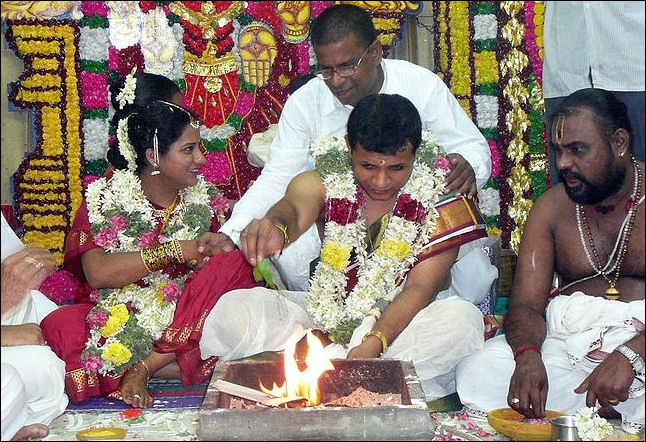
fire ceremony
Hindu Wedding Vows
While standing the groom accepts the bride as a expression of his good fortune and promises to always consult her and include her in their Hindu life together. The mantras that are said while the couple circles the fire includes ones that addresses the responsibilities of love, procreation, mutual respect, fidelity and these are expected to be respected as a long as the couple lives.
As the couple circles the sacred the couple they make seven promises, one for each “step”: 1) to earn enough to care for their families; 2) to live a healthy life; 3) to be concerned with their spouse’s welfare; 4) to live together as friends and bring pleasure and happiness to one another in a religion-oriented life; 5) to eat and drink together and be with each other at special occasions; 6) to have children and love and take care of them; and 7) to adapt to other person at any given time or place. Then the bridegroom chants mantras that includes: “I am the words and you are the melody, I am the melody and you are he words.”
Hindu Wedding Rituals
At the wedding ceremony the father of the bride often hands out red-dyed rice and betel plants as he gives away his daughter and promises to pay all the marriage expenses. The groom’s father takes the bride’s hand and places it in the groom’s hand and then pours priest-blessed water over them. Sometimes gold tinted rice and turmeric are blessed by a priest and repeatedly poured over the bride and groom as a symbol of happiness and prosperity. A tali, or jewel, is placed around the brides neck. Blessings are given. Offerings are made of uncooked rice, barley and sesame. Guests are often given sandalwood paste perfumes and flowers.
Because virginity is regarded as a gift to the groom, the bride’s father says: “I give you, for your son, my beautiful virgin daughter.” In response the groom’s father formally accepts the bride into his family.
After the bride applies sandalwood paste to the groom’s forehead, the groom makes a round red mark, a tikka, on forehead of the bride to indicate that she is now a married woman. When the groom places a garland around her neck he asks the bride to accompany him when he does his Hindu duties. The bride and groom also don wedding necklaces, with a gold or silver chain and black beads and gold semicircles given to them by both families that symbolizes the union of the two families.
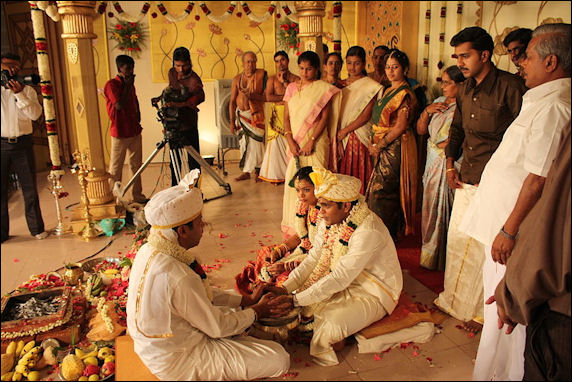
The bride’s parents present gifts to the groom. Sometimes cotton is tied around the bride and groom while blessings for a long life and prosperity are made. The bride eash her hands and the groom prays that they will have success and their dharma will be fulfilled. In India, guests often throw flower pedals at the newlyweds instead of rice. Some people wear their wedding ring on their feet.
Wedding Parties and Events in India
After the bride and groom are united in sacred rites attended by colorful ceremony, the new bride may be carried away to her in-laws' home. The poignancy of the bride's weeping departure for her new home is prominent in personal memory, folklore, literature, song, and drama throughout India. In between all this there is often a wedding party of some sort. [Source: Library of Congress]
Weddings have traditionally been a time when families showed off their wealth. During big wedding brass bands strike up tunes and displays of fireworks are held. Presents include jewelry, cosmetics, clothing and sweets. Some wedding parties feature the bride dancing around with a multilevel tray with lit fires on it. Other weddings feature garlands made from currency notes draped around the necks of the newlyweds by members of the bridegroom's family. In the old days a groom tied a ribbon around the neck of his bride, signaling the marriage was legal and binding.
The wedding ceremony is typically followed by a big feast or party. Everyone is expected to have a good time. Parents of children approaching marriageable age are expected to check out other unmarried children. A fixture of many wedding parties is a “pandal”—a Bengali term for a great tent set up to welcome guests. A middle class wedding with 300 people costs around $3,000. Wedding saris sell for up to $1000 a piece.
As a sort of revenge for purdah (Hindu veiling fo women), women at some Hindu weddings smear red and blue dye on the faces and clothes of the groom and the men accompanying him. They men are not supposed to resist and women even smear goo in their ears and noses. The father of the groom sometimes has to walk around with a cowbell around his neck and his mocked with risque songs by the women. The only one missing out on the fun is the bride who often doesn't attend her own wedding ceremony. [Source: Doranne Wilson Jacobson, National Geographic August 1977]
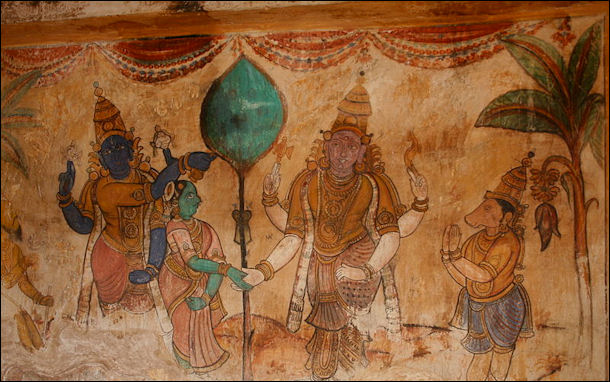
Shiva's marriage
The bride’s family often gives the groom a breakfast of yogurt and jaggery (a confection made from molasses) when he comes to collect her. Somewhere a long the line the couple will find time to stop in a studio for a series of photos in front of a fake Taj Mahal backdrop. The final gesture of the wedding events is for the bride to be welcomed into the house of the groom’s family.
Wedding Presents in India
The Laws of Manu, an ancient Hindu text, says: "Let women be constantly supplied with ornaments at festivals and jubilees." Wedding gifts are delivered to the bride during the wedding festivities on trays carried by attendants of the groom. Bangles and an embroidered veil, traditional gifts for a daughter-in-law, are given to the bride when she returns to the house of husband's family.
Gold jewelry is often given to the bride on her wedding day. A girl from a influential family may find herself with gold rings on each finger, a dozen gold bracelets around her arms; nose rings, ear rings, necklaces, belts, anklets, tiaras, all made of gold. Sometimes she even has gold dust dabbed on her forehead and cheeks.
Elaborate Weddings in India
The most dazzling weddings in Delhi are watched by thousands of guests under red-and-green “shamianas” tents, large enough to cover a city block. Some weddings feature huge paper mache replicas of palaces and things like the Titanic constructed to house the lavish wedding party. Women in gold-and-silver-embroidered silk saris and jewels usually stored in bank vaults arrive in chauffeur-driven cars.
New wealth has resulted in more elaborate wedding ceremonies than ever. In Delhi huge wedding have been held in plaster-and-plywood models of the Great Pyramid of Cheops and a Greek temple with "gods, urns and fluted pilasters." A wedding bankrolled by a wealthy landlord might feature the groom riding on an elephant followed by 50 cars. Some have featured rose pedals dropped from helicopters or airplanes.

Shiva's marriage
Jayalalitha Jayaram, a former movie star and governor of the state of Tamil Nadu, reportedly spent $32 million on his Maharaja-class wedding. Around 150,000 guests feasted under a 30-acre tent. The bridegroom was brought in a chariot. Thirty truckloads of flowers were brought in for the spectacle.
In February 2004, 45 people died and 60 were hurt in a wedding hall fire. The bride was injured and the groom was among the dead, The fire is believed to have been started by a short circuit . Some of the victims died in the flames. Other were trampled as the tried to flee down the only way out—a narrow staircase.
Image Sources: Wikimedia Commons
Text Sources: “World Religions” edited by Geoffrey Parrinder (Facts on File Publications, New York); “Encyclopedia of the World’s Religions” edited by R.C. Zaehner (Barnes & Noble Books, 1959); “Encyclopedia of the World Cultures: Volume 3 South Asia “ edited by David Levinson (G.K. Hall & Company, New York, 1994); National Geographic, the New York Times, Washington Post, Los Angeles Times, Smithsonian magazine, Times of London, The New Yorker, Time, Newsweek, Reuters, AP, AFP, Lonely Planet Guides, Compton’s Encyclopedia and various books and other publications.
Last updated June 2015
